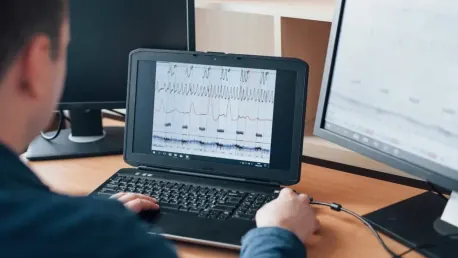In a groundbreaking development, MIT scientists have introduced a novel biosensing technology that leverages light to wirelessly monitor minute electrical signals in biological systems, particularly in liquid environments. This innovative approach, detailed in a paper authored by Benoît Desbiolles and colleagues and published in Science Advances, promises to advance the field of cellular and neural signal monitoring significantly by eliminating the need for traditional wired connections. As the intricacies of cellular communications continue to be a crucial area of research, the advent of wireless biosensing technology could have profound implications for disease diagnosis and targeted treatments.
The Advent of Wireless Biosensing Technology
The core advancement in this research is the development of wireless antennas that replace traditional wired setups. These tiny antennas, known as organic electro-scattering antennas (OCEANs), detect electrical signals through changes in light intensity. This marks a significant departure from conventional methods that rely on wired electrodes connected to amplifiers. The wireless nature of these antennas opens up new possibilities for more flexible and less intrusive monitoring of biological systems. Traditional biosensing devices have often been hampered by the need for complex wires and connections, which can be cumbersome and affect the accuracy of the measured signals.
OCEANs, constructed from a special polymer called PEDOT:PSS, can overcome many of these limitations. The use of light for signal transmission allows for the wireless detection of electrical changes in biological environments, making the monitoring process more streamlined and less obtrusive. This technological innovation not only simplifies the process but also enhances the ability to record electrical signals with greater precision. The polymer responds to electrical activity by altering its refractive index, which in turn affects how it scatters light. This change in light scattering is what allows the antennas to detect and measure electrical signals wirelessly.
High Sensitivity and Resolution
One of the standout features of these antennas is their high spatial resolution. Each antenna is just one hundredth of the width of a human hair, allowing for the precise measurement of electrical signals exchanged between cells. This high sensitivity and resolution cater to the need for high-throughput and high-resolution recordings of cellular electrical activity, making it possible to study cellular communications in unprecedented detail. By leveraging light-scattering phenomena, OCEANs can detect even the most minute electrical changes, offering researchers invaluable insights into the cellular processes driving these signals.
This high-resolution capability is particularly significant for the study of neural communications. Neurons communicate through electrical signals, and understanding these interactions at a detailed level can provide crucial information for neuroscience research. With the ability to monitor these signals wirelessly and with high accuracy, OCEANs pave the way for a deeper understanding of how neural networks operate. This advancement could ultimately lead to new treatments and therapies for neurological disorders. The detailed analysis of electrical signals at this scale was previously unattainable, highlighting the transformative potential of this technology.
Durability and Longevity
The robustness of these devices is another key advantage. Designed to continuously record signals for over 10 hours, these antennas are suitable for long-term studies on cellular communications and their response to environmental changes. This durability ensures that researchers can conduct extended experiments without the need for frequent replacements or interruptions. Long-term stability is essential for studying how cells and neural networks respond to various stimuli over extended periods, providing a more comprehensive understanding of these dynamic processes.
In addition to their robustness, the longevity of these antennas makes them highly reliable for experimental setups that require continuous monitoring. This feature is particularly beneficial for research on chronic conditions or for studying long-term effects of treatments and interventions. The ability to gather uninterrupted data for such durations can lead to more accurate and thorough analyses. The antennas’ design and materials, particularly the PEDOT:PSS polymer, contribute to their sustained performance and reliability, making them a valuable tool for a variety of research applications.
Polymer-Based Transducers
A pivotal discovery in this technology is the use of the PEDOT:PSS polymer, which reacts to electrical activity in the nearby environment by modifying its refractive index. This change affects how the polymer scatters light, allowing the capture of tiny electrical changes during cellular processes. The absence of gold nanoparticles in the polymer composition further enhances the sensitivity and reliability of the antennas. Gold nanoparticles, commonly used in other biosensing devices, can introduce variability and complexity, which this new technology successfully avoids.
The PEDOT:PSS polymer’s ability to alter its refractive index in response to electrical signals enables OCEANs to detect even the slightest changes in their environment. This sensitivity is essential for accurately capturing the nuances of cellular activities, particularly those involving rapid and subtle changes in electrical signals. By focusing on the polymer’s properties, the researchers have developed a material that is both highly responsive and extremely stable. This combination of attributes makes the antennas highly effective for a wide range of applications, from basic cellular research to advanced diagnostic tools.
Compatibility with Standard Microscope Equipment
One of the most user-friendly aspects of this technology is its compatibility with standard optical microscopes. The antennas convert electrical signals into optical signals, which can be analyzed using regular optical microscopes commonly found in biology labs. This makes the technology accessible to biologists who may not be well-versed in electronic instrumentation, facilitating its adoption in various research settings. The ease of integration with existing equipment is a significant advantage, as it removes the barriers associated with adopting new technologies.
The ability to use standard microscopes allows researchers to leverage their existing laboratory infrastructure without the need for specialized equipment. This compatibility not only reduces costs but also simplifies training and implementation processes within research labs. Researchers can focus on their experiments without worrying about learning to use new and potentially complex devices. By providing optical output, OCEANs democratize the technology, making it accessible to a broader range of scientists and researchers.
Efficient and Scalable Fabrication
The fabrication process of these antennas involves nanoscale precision using a focused ion beam. This allows for the creation of arrays consisting of thousands or even millions of antennas. By submerging the chip in a polymer solution and using an electric current, these antennas “grow” from the bottom up, making the production process both efficient and scalable. This scalability ensures that the technology can be produced in large quantities, meeting the demands of extensive research applications.
Scalability is a crucial factor for the widespread adoption of any new technology. The efficient fabrication process developed by the MIT scientists ensures that OCEANs can be produced rapidly and consistently, making them available for widespread use. The ability to create large arrays of antennas not only supports high-resolution measurements but also enables large-scale studies that require multiple sensors. This production capability positions OCEANs well for deployment in various research fields, from basic biological studies to clinical diagnostics.
Applications and Future Directions
The potential applications of this technology are vast. The researchers aim to refine the technology further to allow antennas to penetrate cell membranes for more precise signal detection. Additionally, the integration of OCEANs into nanophotonic devices could lead to next-generation sensors and optical devices with enhanced capabilities. This could revolutionize the way we diagnose diseases, develop targeted treatments, and understand cellular communications. The versatility of OCEANs opens up numerous avenues for future advancements and applications in various scientific fields.
One area of particular interest is the development of more precise diagnostic tools for early detection of diseases. By leveraging the high sensitivity and resolution of OCEANs, it may be possible to identify biomarkers and other indicators of disease at much earlier stages. This could significantly improve patient outcomes by enabling earlier and more accurate interventions. Furthermore, the use of these antennas in therapeutic monitoring can enhance the effectiveness of treatments by providing real-time feedback on how cells respond to various drugs and therapies.
Main Findings and Implications
The development and utilization of OCEANs allow for the wireless monitoring of electrical signals in biological systems with unprecedented spatial resolution. The technology enables the conversion of electrical signals into optical signals, circumventing the need for complex wired setups and amplifiers. This innovation holds promise for better diagnosis and treatment of various conditions by offering deeper insights into cellular behaviors and interactions in response to environmental changes. The ability to monitor electrical signals wirelessly and accurately represents a significant leap forward in the study of cellular communication.
The findings indicate that OCEANs can record electrical signals in a range as low as 2.5 millivolts, enabling precise monitoring of cellular activities. This sensitivity allows researchers to study bioelectrical communications in unprecedented detail, providing valuable insights into how cells and neural networks function. The implications of this technology are vast, spanning from fundamental research to practical applications in medical diagnostics and treatment development. By understanding cellular responses at this detailed level, scientists can develop more targeted and effective therapies, ultimately improving patient care and outcomes.
Real-Time Monitoring and Scalability
OCEANs respond swiftly to changes in electrical signals within milliseconds, enabling real-time monitoring of cellular responses and activities. This aspect is particularly crucial for studying fast signal kinetics, such as those found in neural communication. The robustness and scalability of the fabrication process ensure that these antennas can be produced in large quantities, making them suitable for extensive research applications. The ability to monitor signals in real-time is essential for capturing dynamic processes and understanding the rapid changes that occur within cellular environments.
The swift response time of OCEANs is particularly valuable for neuroscience research, where understanding the rapid firing of neurons is critical. Traditional methods often fall short in capturing these fast changes, but the new technology’s real-time capabilities address this gap. Additionally, the scalability of the antennas ensures that this innovation can be applied to large-scale studies, providing comprehensive data across multiple sensors. This scalability is essential for advancing research in fields that require extensive data collection and analysis.
Future Work and Optimization
In a pioneering advancement, MIT researchers have unveiled a cutting-edge biosensing technology that uses light to wirelessly track tiny electrical signals in biological systems, especially in liquid environments. This groundbreaking method, elaborated in a paper by Benoît Desbiolles and fellow researchers and published in Science Advances, is poised to revolutionize cellular and neural signal monitoring by removing the dependence on conventional wired connections. As the complexity of cellular communication remains a pivotal research area, this new wireless biosensing technology could have significant ramifications, enhancing disease diagnosis and enabling more precise treatments. The potential of this technology extends to various fields, such as neurology and medical research, offering a new, efficient way to gather critical data from living organisms. Effectively, this innovation could lead to the development of advanced diagnostic tools and therapies tailored to specific cellular activities, marking a substantial leap forward in biomedical science.









